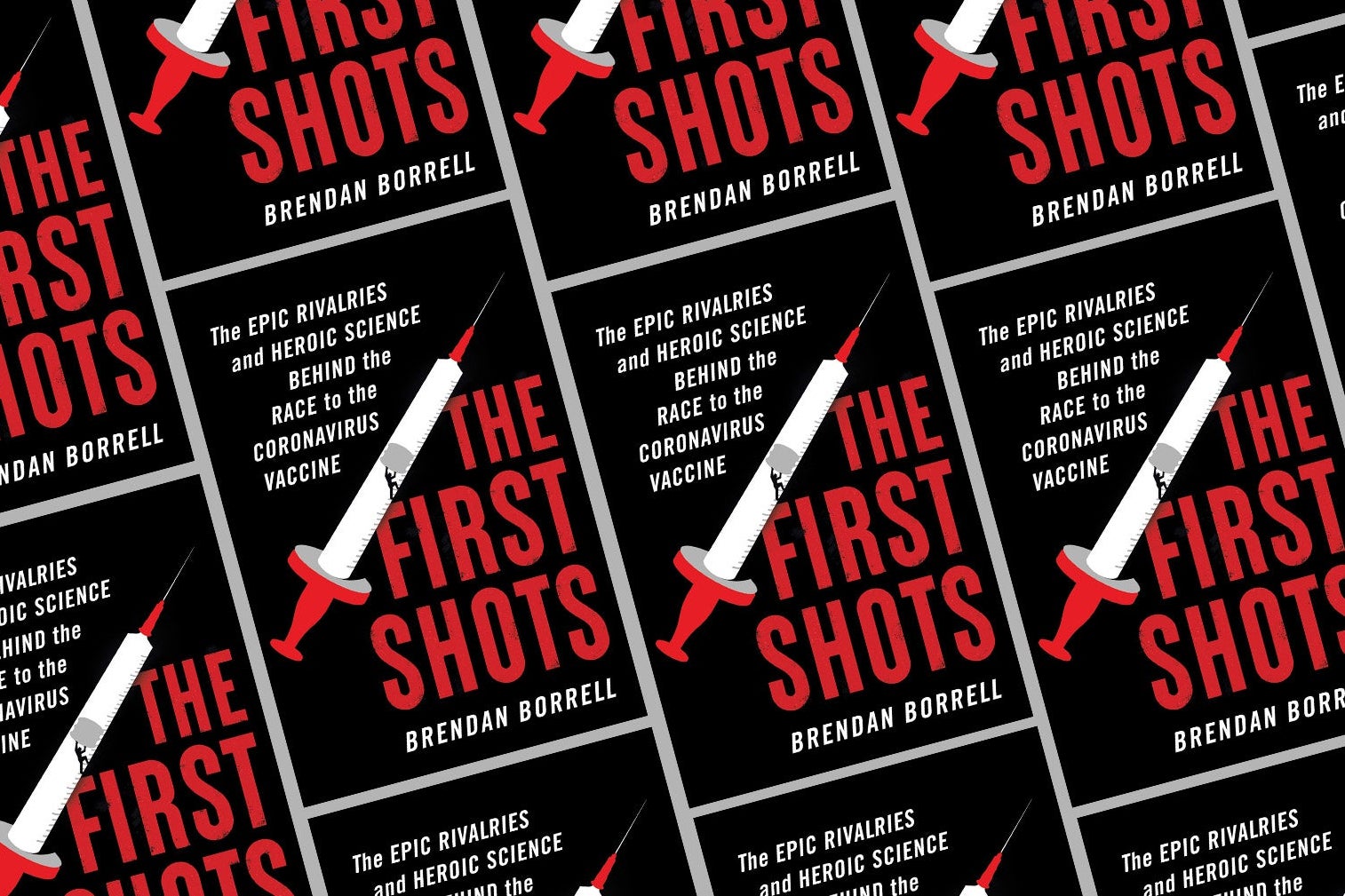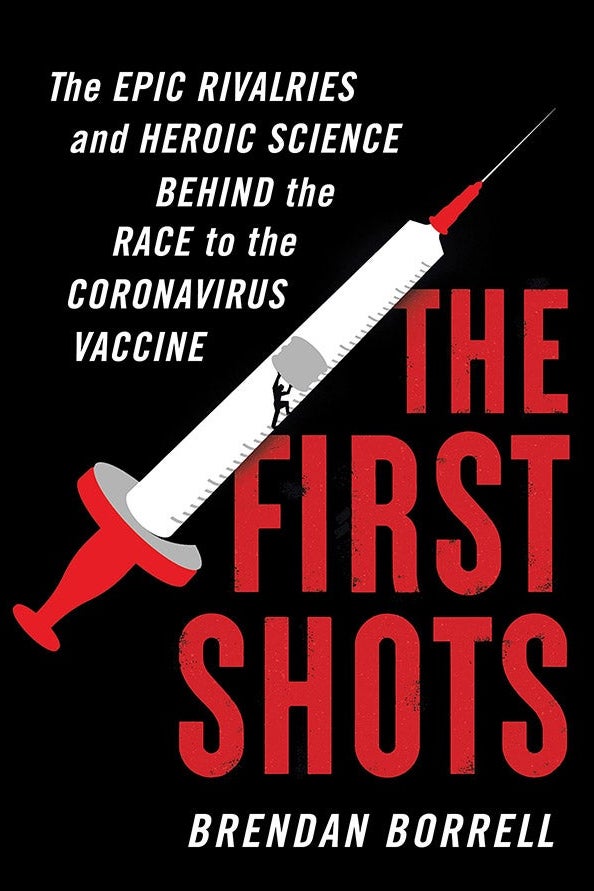Slate has relationships with various online retailers. If you buy something through our links, Slate may earn an affiliate commission. We update links when possible, but note that deals can expire and all prices are subject to change. All prices were up to date at the time of publication.
Excerpted from The First Shots: The Epic Rivalries and Heroic Science Behind the Race to the Coronavirus Vaccine by Brendan Borrell. Reprinted with permission of Mariner Books, an imprint of HarperCollins Publishers. Copyright © 2021 by Brendan Borrell.
Four days before Chinese researchers released the genome sequence of the novel coronavirus, Jason McLellan was standing inside a crowded ski shop in Park City, Utah, waiting to get a pair of new snowboarding boots heat-molded to his feet. His phone buzzed in his pocket. He glanced down at the screen. It was his former mentor Barney Graham, a vaccine researcher at the National Institutes of Health. McLellan had left the NIH seven years earlier and was now an associate professor in Austin, Texas, albeit the kind of professor who gives lectures in a pair of shorts and a Star Wars T-shirt.
McLellan slipped outside to take the call. The pneumonia cluster in Wuhan was potentially caused by a coronavirus, Graham said. He was making plans to design and test a vaccine for it as quickly as possible, and he wanted McLellan to sign on. At that particular moment on the morning of January 6, 2020, neither thought that humanity was necessarily facing a pandemic. It was in the back of Graham’s mind, for sure, but it was always in the back of Graham’s mind, considering his line of work.
A doctor and virologist, Graham was an unassuming Midwesterner, six foot five with broad, sloping shoulders and a gray beard. For nearly twenty years, Graham had worked at the NIH’s Vaccine Research Center (VRC), where he studied the way certain viruses caused the immune system to go haywire. He got a far-off look in his eyes when he spoke about the viruses he had tangled with, evincing the grudging respect of a rancher for the coyote that has taken another calf. When he turned sixty, the onetime farm boy from Kansas bought himself an F-150 pickup truck with burgundy seats. His license plate: vaxin8r.
Located nine miles from the U.S. Capitol, the VRC — in Building 40 on the NIH’s grassy, university-like campus in Bethesda, Maryland — was originally established to address the HIV/AIDS pandemic, but Graham delved into lesser-known diseases. He knew that the world had seen viruses spill over from wild-animal populations into humans many times, with devastating consequences. HIV had come from chimpanzees, likely via a hunter who had infected himself while butchering an animal for its meat.
As Graham had discussed with Anthony Fauci, the renowned infectious diseases doctor who had recruited him to the NIH, there were certain things that scientists could do to help prepare humanity for the next outbreak. Animal-borne diseases that once might have been confined to a remote cave in the middle of a tropical forest now posed global threats, given that it was easier than ever for a person just about anywhere to hop on a bus in the morning and be on an international flight by the afternoon. In the past decade, the WHO had declared four public health emergencies related to zoonotic diseases: swine flu in 2009, Ebola in 2014 and 2018, and Zika in 2016. What would the next one be?
Some experts referred to the potential danger on the horizon as disease X, and Graham had an idea about how we — humanity — might work together to stop it. There were about 120 viruses known to pose a potential risk to people. Those viruses could be divided into twenty-five different families. There were licensed vaccines for viruses in just thirteen of those families. Most global-health efforts focused on the troubling pathogens that had emerged in the past — but that left a whole swath of the viral landscape unknown, unprobed, unprotected against. Over the past decade, Graham had been advocating for also studying representatives in the twelve virus families for which there were no vaccines. By developing a vaccine strategy against these “prototype pathogens,” researchers would have a head start if any of their close relatives emerged one day. Instead of being one step behind an outbreak, Graham wanted humans one step ahead. Going after this new coronavirus in China was going to be a flex, a demonstration of how fast science could move in the face of a new threat.
Graham knew there was no one faster than Jason McLellan. McLellan was Graham’s structural-biology guru, the person who could tell him the precise shape of the different parts of this virus.
After McLellan hung up the phone, he fired off a WhatsApp message to one of his brightest graduate students back at the University of Texas at Austin, Daniel Wrapp, who had been involved in a previous coronavirus vaccine study a few years earlier. “Graham is going to try and get the coronavirus sequence out of Wuhan China,” he wrote. “He wants to rush a structure and vaccine, etc. You game?”
Wrapp responded a minute later. “Should be straightforward other than the rush,” he wrote. “Sounds like it could be fun.”
Over the weekend, Graham and his collaborators came up with a final design for their vaccine, which would present just the spike protein of the coronavirus to the body’s immune system. On Monday, January 13, he walked across the NIH campus to Building 31, the executive offices. He was meeting with Tony Fauci. The son of a pharmacist in Brooklyn, Fauci had made his name studying the tricks HIV uses to break down the body’s defenses. He was seventy-nine, but he was as sharp as ever, a walking multiprocessor with darting eyes and the decisiveness of an army general. This was a guy who had been the captain of his high-school basketball team even though he was one of the shortest players on the court. He had been offered the directorship of the NIH multiple times, a political appointment, but he had chosen to remain the head of one of its institutes, the National Institute of Allergy and Infectious Diseases, or NIAID, for more than thirty years. It was a post that gave Fauci the ability to speak his mind without fear of repercussions. In a visit to the Clinton White House in December 1996, Fauci had proposed creating a research center to develop vaccines against AIDS. A quarter of a century later, Graham told Fauci the Vaccine research Center was wielding all the scientific tools it had developed for that unfinished mission against this new foe.
But science alone was not going to be enough. The NIH team had to select the right technology to deliver its spike-based vaccine to the body. Graham did not need to remind Fauci that he and the director of the VRC, John Mascola, had struggled to find a commercial manufacturing partner during the Zika outbreak several years earlier. But at the last minute, the VRC scientists were asked to run tests on monkeys with an mRNA vaccine produced by a biotech company called Moderna and were galvanized by those results. Unlike traditional vaccines that contained whole viruses or virus proteins, Moderna’s still-unproven method delivered to human cells only the genetic instructions they needed to make those proteins. In the fall of 2019, the company’s CEO, Stéphane Bancel, had offered to manufacture a pilot lot for the next disease Graham wanted to attack for his pandemic demonstration project. On January 7, Bancel, at his vacation home in the South of France, read the news about the coronavirus. He had e-mailed Graham, eager to begin.
Fauci had only one question for Graham: “Do you need money for the pilot lot?”
“No,” Graham said. The VRC had already set aside some money for this program, and Bancel was looking for more. He was always looking for more.

